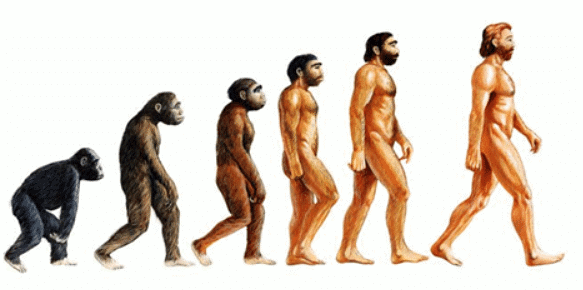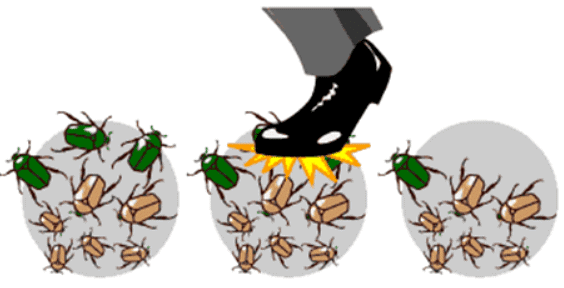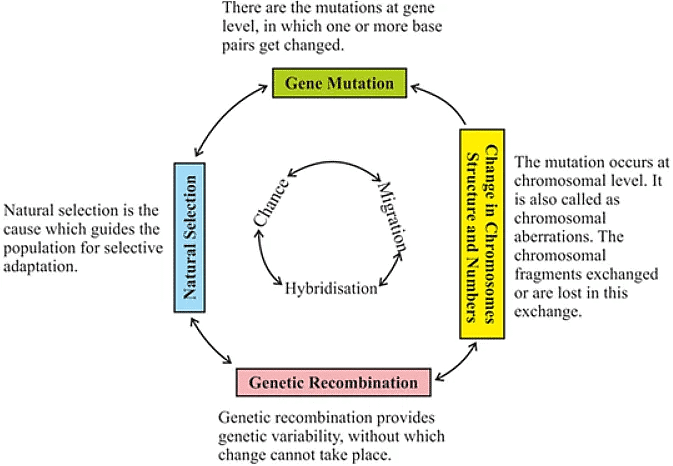Synthetic Theory of Evolution (Post-Darwinian) | Anthropology Optional for UPSC PDF Download
| Table of contents |

|
| Introduction |

|
| Modern Synthetic Theory of Evolution |

|
| Conclusion |

|
| Frequently Asked Questions (FAQs) for Synthetic Theory of Evolution |

|
Introduction
The Synthetic Theory of Evolution, also known as Neo-Darwinism, is an updated version of Charles Darwin's theory of Natural Selection. This modern theory emphasizes that only genetic variations occurring at the gene level, known as mutations, are responsible for evolution and inheritance, rather than all variations as suggested by Darwin. The Synthetic Theory is a combination of Darwin's ideas and Hugo de Vries' theories, and was developed through the collaborative work of numerous scientists such as T.Dobzhansky, R.A Fisher, J.B.S Haldane, Swell Wright, Ernst Mayr, and G.L. Stebbins.

Modern Synthetic Theory of Evolution
The Modern Synthetic Theory of Evolution, also referred to as Neo-Darwinism, is a combination of Charles Darwin's original theory of evolution and contemporary genetics. This theory is based on several key principles, including:
- Genetic variability
- Natural Selection
- Reproductive Isolation
In addition to these core principles, other factors can also influence the process of evolution. These include migration, which occurs when individuals from one population move to another, and hybridization, which is the interbreeding between closely related species or races. Both of these factors can increase the genetic variability within a population, thereby providing more opportunities for evolution to occur.
1. Gene Variability
This principle states that within any given population, there is genetic variation. This means that variations exist within a population due to certain genetic changes present in its members.
The primary causes of gene variability include:
(i) Mutation: These are sudden inheritable changes that occur due to permanent alterations in an organism's genotype. Mutations can be either chromosomal or gene mutations.
- Chromosomal mutation– This refers to changes in the number or structure of chromosomes. Chromosomal mutations can be divided into two categories:
I. Morphological aberrations– These occur when there are changes in the shape of chromosomes, resulting from events such as addition, deletion, translocation, and inversion.
II. Numeric mutation– These mutations occur when there is a change in the number of chromosomes. There are two types: Aneuploidy and Euploidy.- Aneuploidy: This is a condition in which an organism has either fewer or more chromosomes than normal. Examples include:
Monosomy– The absence of one chromosome from a pair (2N–1). An example is Turner's Syndrome (44 + X).
Nullisomy– The absence of a pair of homologous chromosomes (2N – 2).
Trisomy– The presence of an extra chromosome. An example is Down's Syndrome (2N + 1).
Tetrasomy– The addition of two chromosomes (2N + 2). - Euploidy: This occurs when the chromosome number changes by a complete set. For example, haploid refers to a change of one set of chromosomes, diploid refers to a change of two sets, and so on (triploid, polyploid, etc.).
- Aneuploidy: This is a condition in which an organism has either fewer or more chromosomes than normal. Examples include:
- Gene Mutation- This refers to a change or mutation in a specific location, point, or nucleotide. It can result from the addition or deletion of a nitrogenous base or the substitution of one nitrogenous base with another. Addition or deletion of a nitrogenous base can lead to a frameshift mutation.
(ii) Recombination: This process occurs during meiotic cell division when homologous chromosomes undergo vertical splitting to form sister chromatids. Non-sister chromatids cross over and exchange genetic material, which is called recombination. This process also contributes to gene variability.
(iii) Hybridization: When two species are crossed, the resulting offspring are called hybrids, which exhibit variability.
(iv) Genetic drift: This phenomenon occurs when genes or alleles of certain traits are eliminated from a population due to random events such as disease, natural disasters, etc. This significantly alters the gene frequency of the remaining population and is known as genetic drift, allelic drift, or the Sewall Wright Effect. It is more commonly observed in small populations.
 (v) Heredity: The transfer of characteristics from parents to their offspring also plays a role in the process of evolution.
(v) Heredity: The transfer of characteristics from parents to their offspring also plays a role in the process of evolution.
2. Natural Selection
- The organism which is selected by nature is stronger or better adapted to its environment is selected by nature, and the rest are eliminated from nature is called natural selection. This was emphasized by Darwin.
- But actually, Natural Selection means differential reproduction. Some members of a population have genes that enable them to grow and reproduce at a faster rate. When such members reproduce, they give more offspring. This will contribute a greater percentage of genes to the next generation.
- If differential reproduction continues for many generations, genes of the individuals which produce more offspring will become predominant in the gene pool of the population. This leads to a change in the gene frequency of a population.
- Some phenotypes within a population are better adapted to some environmental changes and hence are more likely to survive and reproduce than other phenotypes. A common example is an Industrial melanism, a phenomenon depicted by peppered moths.
3. Reproductive Isolation
Reproductive isolation is a process that stops interbreeding between populations of two distinct species, helping to maintain each species' unique characteristics and potentially leading to the creation of a new species. This can occur through various mechanisms, including:
- Geographical isolation: This occurs when physical barriers, such as oceans, mountains, deserts, or rivers, separate related groups of organisms. As a result, these groups cannot interbreed due to their physical distance from one another.

- Temporal isolation: This type of isolation happens when two species are unable to mate because they breed at different times throughout the year. Since their mating seasons do not overlap, individuals from the two species cannot interbreed.
- Behavioural isolation: In this case, two groups of organisms are prevented from interbreeding due to differences in their mating rituals and courtship behaviors. These distinct behaviors may not be recognized or accepted by individuals of the other species, leading to a lack of successful mating attempts.
- Mechanical isolation: This form of isolation is caused by differences in genitalia size or structure between species, which can make interbreeding difficult or even impossible. The incompatible reproductive structures prevent successful mating between individuals from the two different species.
Conclusion
The Modern Synthetic Theory of Evolution, also known as Neo-Darwinism, is an updated and comprehensive version of Charles Darwin's original theory of evolution, incorporating contemporary genetics. This theory is based on three key principles: genetic variability, natural selection, and reproductive isolation. Various factors, such as mutation, recombination, hybridization, genetic drift, and heredity, contribute to genetic variability within populations. Natural selection favors individuals with better adaptation to their environment, leading to differential reproduction. Reproductive isolation, through geographical, temporal, behavioral, or mechanical barriers, prevents interbreeding between different species, maintaining their unique characteristics and potentially leading to the creation of new species. Overall, the Modern Synthetic Theory of Evolution provides a well-rounded explanation of how evolution occurs and how species diversify over time.
Frequently Asked Questions (FAQs) for Synthetic Theory of Evolution
What is the primary difference between Darwin's original theory of evolution and the Modern Synthetic Theory of Evolution?
The primary difference is that the Modern Synthetic Theory of Evolution incorporates contemporary genetics and emphasizes genetic variation at the gene level (mutations) as the main driver of evolution and inheritance, while Darwin's original theory focused on variations among all individuals within a population without the understanding of genetics.
What are the main causes of gene variability in a population?
The main causes of gene variability in a population include mutation, recombination, hybridization, genetic drift, and heredity.
How does natural selection contribute to the process of evolution?
Natural selection favors individuals with better adaptations to their environment, leading to differential reproduction. Over time, the genes of these well-adapted individuals become more prevalent in the population, resulting in a change in the overall genetic makeup and potentially giving rise to new species.
What is reproductive isolation, and why is it important in the process of evolution?
Reproductive isolation is a process that prevents interbreeding between populations of two distinct species, helping to maintain each species' unique characteristics and potentially leading to the creation of new species. It is important in the process of evolution because it ensures that distinct species do not merge back together through interbreeding, preserving the diversity of life.
|
209 videos|299 docs
|















